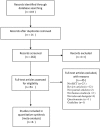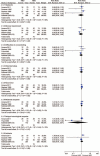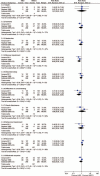Treatment with normobaric or hyperbaric oxygen and its effect on neuropsychometric dysfunction after carbon monoxide poisoning: A systematic review and meta-analysis of randomized controlled trials
- PMID: 30278526
- PMCID: PMC6181555
- DOI: 10.1097/MD.0000000000012456
Treatment with normobaric or hyperbaric oxygen and its effect on neuropsychometric dysfunction after carbon monoxide poisoning: A systematic review and meta-analysis of randomized controlled trials
Abstract
Background: Carbon monoxide (CO) poisoning may result in acute neurological sequelae, cognitive sequelae, and delay neurological sequelae. The administration of hyperbaric oxygen (HBO) to prevent the development of delayed neurological sequelae in CO poisoning have extensively investigated but conflicting results have been reported. We performed a systematic literature review and meta-analysis of randomized controlled trials (RCTs) evaluating HBO treatment and its effect on neuropsychometric dysfunction after CO poisoning.
Methods: We searched Medline, Embase, Pubmed, and the Cochrane Register of Controlled Trials from inception to December 2017. Eligible studies compared HBO therapy with normobaric oxygen (NBO) in patients with CO poisoning.
Results: Six studies compared HBO with NBO in CO poisoning patients. Compared with patients treated with NBO, a lower percentage of patients treated with HBO reported headache (16.2% vs 16.5%, relative risk [RR] = 0.83, 95% CI = 0.38-1.80), memory impairment (18.2% vs 23.8%, RR = 0.80, 95% CI = 0.43-1.49), difficulty concentrating (15.0% vs 18.4%, RR = 0.86, 95% CI = 0.55-1.34), and disturbed sleep (14.7% vs 16.2%, RR = 0.91, 95% CI = 0.59-1.39). Two sessions of HBO treatment exhibited no advantage over one session.
Conclusions: The meta-analysis indicated that compared with CO poisoning patients treated with NBO, HBO treated patients have a lower incidence of neuropsychological sequelae, including headache, memory impairment, difficulty concentrating, disturbed sleep, and delayed neurological sequelae. Taking into consideration the cost-effectiveness of one session of HBO, one session of HBO treatment could be an economical option for patients with CO poisoning with high severity.
Figures



References
-
- Shie HG, Li CY. Population-based case-control study of risk factors for unintentional mortality from carbon monoxide poisoning in Taiwan. Inhal Toxicol 2007;19:905–12. - PubMed
-
- Norris CR, Jr, Trench JM, Hook R. Delayed carbon monoxide encephalopathy: clinical and research implications. J Clin Psychiatry 1982;43:294–5. - PubMed
-
- Weaver LK, Hopkins RO, Elliott G. Carbon monoxide poisoning. N Engl J Med 1999;340:1290author reply 1292. - PubMed
-
- Jay GD, McKindley DS. Alterations in pharmacokinetics of carboxyhemoglobin produced by oxygen under pressure. Undersea Hyperb Med 1997;24:165–73. - PubMed
-
- Hampson NB, Simonson SG, Kramer CC, et al. Central nervous system oxygen toxicity during hyperbaric treatment of patients with carbon monoxide poisoning. Undersea Hyperb Med 1996;23:215–9. - PubMed
Publication types
MeSH terms
Substances
LinkOut - more resources
Full Text Sources
Medical

